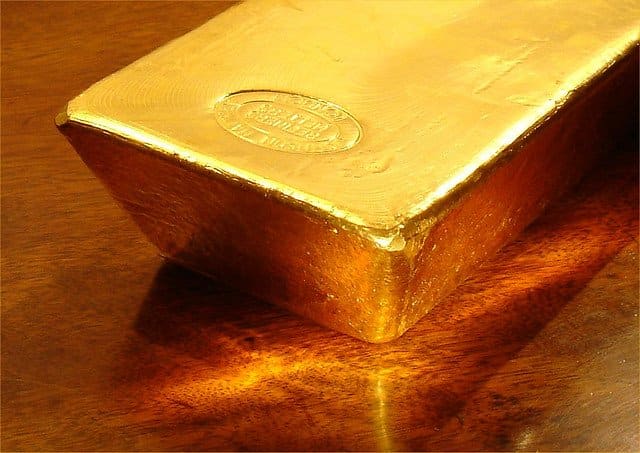Understanding Gold Purity: 9K, 10K, 14K, 18K, 22K, and 24K

The stamp on this piece of gold could indicate what use it's intended for and how many, if any, other metals were added to it.
How Is Gold Graded and Valued?
Many of us, at one point or another, will shop for gold in the jewelry department of a department store or in a jewelry store.
If you've ever gone shopping for jewelry, you are probably familiar with the word “karat” as applied to gold. The higher the karat, the more expensive it will be. But have you ever wondered why? The short answer is that higher karats mean more gold, but there’s more to it than that.
What does it all mean? And what is all of that fine print stamped into your piece of gold? What are karats, really? How do you know how pure that gold really is? This article will answer these questions and more.
What Are Karats?
Karats, spelled "carats" outside of North America, are the little numbers stamped on a piece of gold in the format of "xxK" or "xxKT". The numbers refer to the type of gold and to the actual gold content in the particular piece of jewelry.
Here’s more information on karats:
- Karat is a measurement of the ratio of gold to other metals or alloys.
- Karats are measured on a scale from 0 to 24.
- The higher the karat number, the more gold there is and the less other metal content.
- Other metals and alloys could include copper, nickel (not common anymore), silver, or palladium.
With this in mind, 24-karat gold is the purest gold you can buy.
Why Are Other Metals Added to Pure Gold?
Gold is malleable in its pure state. Other metals are added to strengthen it and in some cases to enhance color. An example is "rose gold" comprises gold and copper.
How to Use Karats to Measure Gold Purity
Knowing the number of karats is key to calculating the gold content on your own. Here is how to use the number of karats to figure out how pure your piece of gold is.
Say you purchase a ring that is 14K gold. Since the number amount of karats you can have is 24K, divide the 14 Karats by the 24. You will get .583. This means that the gold is 58.3% pure.
Gold Purity Conversion Chart
| Number of Karats | Parts of Gold | % of Gold Purity | Millesimal Fineness |
|---|---|---|---|
9K | 9/24 | 37.5 | 375 |
10K | 10/24 | 41.7 | 416/417 |
12K | 12/24 | 50.0 | 500 |
14K | 14/24 | 58.3 | 583/585 |
18K | 18/24 | 75.0 | 750 |
22K | 22/24 | 91.7 | 916/917 |
24K | 24/24 | 99.9 | 999 |
As you can see in the above chart, "millesimal fineness" refers to the percent of gold, while karats refer to the ratio of gold to other metals in the piece. Converting between the two is rather easy when you convert the percent to fraction form, or vice versa.
Gold Purity Terminology: What Is Gold "Fineness"?
The measure of gold purity, or fineness, refers to the gold-to-metal additive ratio. Let’s look at a few terms that you may come across when studying about or shopping for gold:
- Assay: A test that determines metal content and quality
- Bullion: Precious metals in a bulk, uncoined form such as gold bars, considered in mass rather than value
- Carat: Not to be confused with "karat" in North America, a carat is a unit of weight used for precious stones. One carat is equal to 200 milligrams. Outside of North America, carat is used in the same context as karat.
- Ductile/Ductility: How capable a metal is of being deformed using tensile force (e.g., Ductile materials can be stretched into thin wires without fracture)
- Hallmark: A symbol or mark stamped on a piece of precious metal that certifies its standard of purity
- Karat: Unit of measurement for the fineness of gold, with the higher numbers containing more gold and 24K being the finest
- Malleability: How capable a metal is of being deformed using compressive force. (e.g., More malleable metals can be hammered or rolled into thin sheets)
- Millesimal Fineness: A system used to show the purity of precious metals by parts per thousand rather than karats
- Troy Ounce: 31.1034768 grams, or approximately 1.09714 standard “avoirdupois” ounces
- Troy Weight: A system of measurement used for gemstones and precious metals, where a full Troy pound consists of 12 “troy” ounces rather than the 16 “avoirdupois“ ounces in a standard pound
What Do the Stamps on Gold Mean?
Here’s a list of stamps you might find on a piece of gold and what they mean.
- EPNS—If someone is trying to sell you a piece of “gold” marked “EPNS,” run away. It stands for “Electroplated Nickel Silver,” which is silverplate. This means the piece is not gold, and it’s worthless.
- EPBM—Again, if someone is trying to sell you “gold” marked “EPBM,” go elsewhere. This stands for “Electroplated Britannia Metal,” which is not gold at all. It is a silver/tin alloy consisting of copper, lead, or zinc.
- GE—Gold Electroplate is a piece consisting of a base metal, often brass, with a certain thickness of gold electrolytically deposited onto the base. The minimum standards require to be considered GE is 7 millionths of an inch and at least 10K gold as the plating.
- HGE—This also refers to Heavy Gold Electroplate, the same as GE above, but it can only make the "heavy" classification if the plating is at least 100 millionths of an inch.
- GF—This means "gold filled" and is like gold plate but the gold is heat- and pressure-bonded to the base metal. It must have a minimum purity of 10K gold and the gold content must be at least 1/20th of the weight of the metal piece.
- 375—This means the gold is 37.5% pure, or 9K. In the US, the minimum standard for gold is 10K. Many other countries allow marketing this as gold and it’s been used in both jewelry and dental applications.
- 417—This means that the gold is 41.7% pure, or 10K. In the US, jewelers uses this purity because it is very strong. It is great for jewelry for those who work industrious jobs or who need something that will hold up.
- 585—This means that the gold is 58.5% pure, or 14K. Good, strong gold but with more gold than 10K.
- 750—This means that the gold is 75.0% pure, or 18K. Much more pure than 14K, still has good strength with a wonderful balance in purity.
- 916—This means that the gold is 91.6% pure, or 22K. This is probably the softest and most pure gold you would want to have for a piece of jewelry.
- 999—This means the gold is 99.9% pure, or 24K. This is the purest that you can buy, and although purity can be up to six nines fine, or 999.999, it’s highly rare to find it so pure. Such fineness in gold was last refined in the 1950s by the Perth Mint in Australia.
Does High Karat Mean Higher-Quality Gold?
Purer gold does not mean better, it means more pure, worth more money, and more expensive. With gold, the phrase “less is more” can certainly apply. As stated earlier, the less pure the gold is, the more alloy metals it contains. Gold that is blended with more alloys is stronger. This may be preferable especially for jewelry as 24K gold is very soft and not as durable.
The lower the karats in a ring, the stronger it will be. Let’s compare lower and higher karats:
- The lower the karat, the stronger it will be, while higher karat gold will be softer.
- Lower karat gold is not tarnish-resistant. Higher karat gold is much more resistant to tarnishing.
- Lower karat gold is not worth as much monetarily. Higher karat gold is more valuable because it is purer.
- Higher karat gold will appear more yellow.
Choose the purity level that makes the most sense for what you intend to use it for, whether you will subject it to a lot of force, and your personal preferences.
Common Uses for Gold
Although over 75% of the gold used every year is made into jewelry, there are other uses. Gold is very flexible and is used in many industries for various purposes, depending on the purity. Many industries use gold for jewelry-making all the way to food applications.
- Coins/bullion: Currency is one of the greatest uses as gold will always hold value even if the dollar collapses. Take American Buffalo coins, for example; they are 24K gold, pure as pure can be!
- Computers/technology: Since gold is a terrific conductor of electricity, it is often found in computers and technology. You will even find small amounts in cell phones, about $.50 worth!
- Aerospace: Being such a great conductor, various circuit boards for spacecrafts use gold as a shield to keep the temperature of the spacecraft stable.
- Dental: We’ve all seen rappers with golden grills. Gold is not just for looks though! It’s highly useful in the mouth and can be found in fillings, crowns, bridges and other dental applications.
- Medical: Not only is gold used in medical appliances and instruments, but it is also literally used as a “drug” for medical purposes for various conditions, including radiation treatment for certain types of cancer!
As far as food goes, don’t go eating that engagement ring in a life or death situation! Some restaurants use gold as a decorative, but edible garnish for food since the food-grade gold is non-toxic. You may also be familiar with the liquor Goldschläger, which contains visible pieces of gold flakes. So forget the cake, you can have your gold and eat it too!
Purpose of Stamps or Hallmarks
While you may come across some pieces of gold that are not stamped with purity, most gold, especially jewelry, will come stamped with what's called a "hallmark" as a reference and even a selling point. Jewelry stores or big box stores in the U.S. stamp all gold with purity. While U.S. gold standards enforce the stamping of purity somewhere on the jewelry, you may still come across a piece of unmarked jewelry, such as antique or handmade pieces.
The stamps and any laws behind stamping jewelry will vary by country, and if you come across an unstamped piece of gold that is marketed as of a certain purity, it’s best to proceed with caution and test the gold using a gold testing kit.
Sometimes, jewelry that is stamped as being a certain purity can be fake or misrepresented. This is more common when ordering online from a foreign country. Usually in cases like these, the price is a good indicator of faux metals. The adage “you get what you pay for” holds true, especially when dealing with precious metals. Should you find yourself in the receiving end of such a situation, it’s a good idea to file a report with the Federal Trade Commission (FTC).



